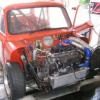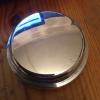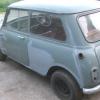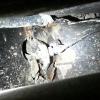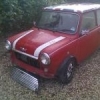Alloy Suspension Parts
#16

Posted 30 January 2013 - 09:37 AM
Also, the rear radius arm as it is (although bendable) is quite over engineered, so the alloy KAD arm is a decent replacement. But as siad above, there is no real replacemet for the front end. My Hillclimber has Ti front suspension, but it only does a few hundred miles a year at most.
finally, making lightweight suspension parts is really for leightweight cars. For instance, my top arms have been lightened on my hillclimber, but I wouldn't do it on the road car that weighs 200kgs more and can carry 4 people.
#17

Posted 30 January 2013 - 11:06 AM
Aircraft OLEO legs, these are the legs that support the aircraft when it lands etc...
#18

Posted 30 January 2013 - 12:09 PM
I may never get the benefit of the lightened suspension but it is more of an engineering project and I like to have something different to the norm.
I agree with the alloy upper arms so will go another route but can't see a problem with rear alloy billet radius arms as I will be running coil overs.
#19

Posted 30 January 2013 - 12:58 PM
alloy ones (of same design) should bend easier ?
lateral force when cornering , especially when combined with a kerb / pot hole , is high
if you are out to lose un sprung weight - why not go for 10' wheels on the back
unless it's for looks
Edited by sledgehammer, 30 January 2013 - 01:30 PM.
#20

Posted 30 January 2013 - 01:36 PM
#21

Posted 30 January 2013 - 04:30 PM
Neilson, running coilovers does not remove the braking and cornering loads from the radius arms, but in a road car does add many more problems.
#22

Posted 30 January 2013 - 06:56 PM
Edited by 03jkirk, 30 January 2013 - 06:56 PM.
#23

Posted 30 January 2013 - 08:36 PM
The big problem with using alloy parts on a road car is fatigue, as allow does not have a fatigue threshold, unlike steel, and will always fail after a certain number of load cycles. Suspension parts designed for competition use, which generally means limited mileage, are dangerous on the road, as the fatigue life will be used up well within the lifespan of a normal road car. Badly fitted ball joints apart, suspension fractures on a normal Mini are almost unheard of, however if you use alloy parts, expect them to break. The big problem is that because the loads applied to a road car are very variable, you can't predict what the safe life will be, for example kerbing might use up half the fatigue life in an instant. Unless the designers clearly state their design load assumptions and predicted life, I would be very wary indeed.
A radius arm, for instance, which is alloy will probably need to be as heavy as a steel one to get 100k miles of normal road use. Top arms are a complete no-no because of the loading, because they would have to be impossibly thick.
For safety's sake you should stick to steel. The limiting factor on the life is corrosion, as they are designed to be stressed significantly below the fatigue threshold, and so are safe for unlimited mileage.
An alloy part of the same dimensions as the original steel part is unsafe, as it will be lacking in both fatigue and static strength.
Does this not make alloy wheels dangerous?
Alloy wheels are a lot thicker than steel ones..
#24

Posted 30 January 2013 - 10:06 PM
Unlike road cars, aircraft are weight critical, as are racing cars.
#25

Posted 30 January 2013 - 11:42 PM
With aviation every aircraft type has a structural test rig which subjects a test airframe to full flight loads including cabin pressurisation and wing flexing to simulate the loadings an aircraft will be subjected to in flight. The structural test rig must always be, from memory, about 40% ahead of the highest hours aircraft of that model in simulated flight hours and flight cycles. With unpressurised aircraft different rules apply, but they are still very stringent in terms of testing and major overhauls.
Unlike road cars, aircraft are weight critical, as are racing cars.
What I would like to know, is how ww2 warbirds are alowed to fly? They're laregely of unknown history, who knows when a crack will appear or worse. I supose it is slightly different as it's usually only the pilot who's fully aware of the risks involved, but there's still thousands of people at every air show.
#27

Posted 31 January 2013 - 12:45 AM
http://www.planeandp...is-too-old.html
Is worth a read
Thanks for that, it's very interesting.
I co-own, with a friend, a 1965 vintage Schleicher Ka6CR sailplane. It's of wooden construction and we are very thorough with our maintenance. I also have a share in a Slingsby T21B glider which was built in about 1953. That is also made of wood and is in good condition. We do take our maintenance very seriously.
#28

Posted 31 January 2013 - 01:08 AM
http://www.planeandp...is-too-old.html
Is worth a read
Thanks for that, it's very interesting.
I co-own, with a friend, a 1965 vintage Schleicher Ka6CR sailplane. It's of wooden construction and we are very thorough with our maintenance. I also have a share in a Slingsby T21B glider which was built in about 1953. That is also made of wood and is in good condition. We do take our maintenance very seriously.
Yes I use Ron Seal on my fence its good stuff isn't Peter
#29

Posted 31 January 2013 - 08:42 AM
alloy wheels are mostly safe as they are very thick, but some cheaply made aftermarket alloys can be dangorus is put under hard load, original porche 911 alloy split rims are extremely rare nowday because they had a massive problem with cracking as they did not have enough material to make them strong enough, also as was said to be as strong as steel they have to be as much weight of alloy to cope and ally wheels are generally heavier than equivilant steel wheels due to the extra material
Example of cheap aftermarket wheels

#30

Posted 31 January 2013 - 03:21 PM
I always wonder about the alloy re-conditioners that come to your house & tart up kerbed rims
covering up a multitude of sins
0 user(s) are reading this topic
0 members, 0 guests, 0 anonymous users



